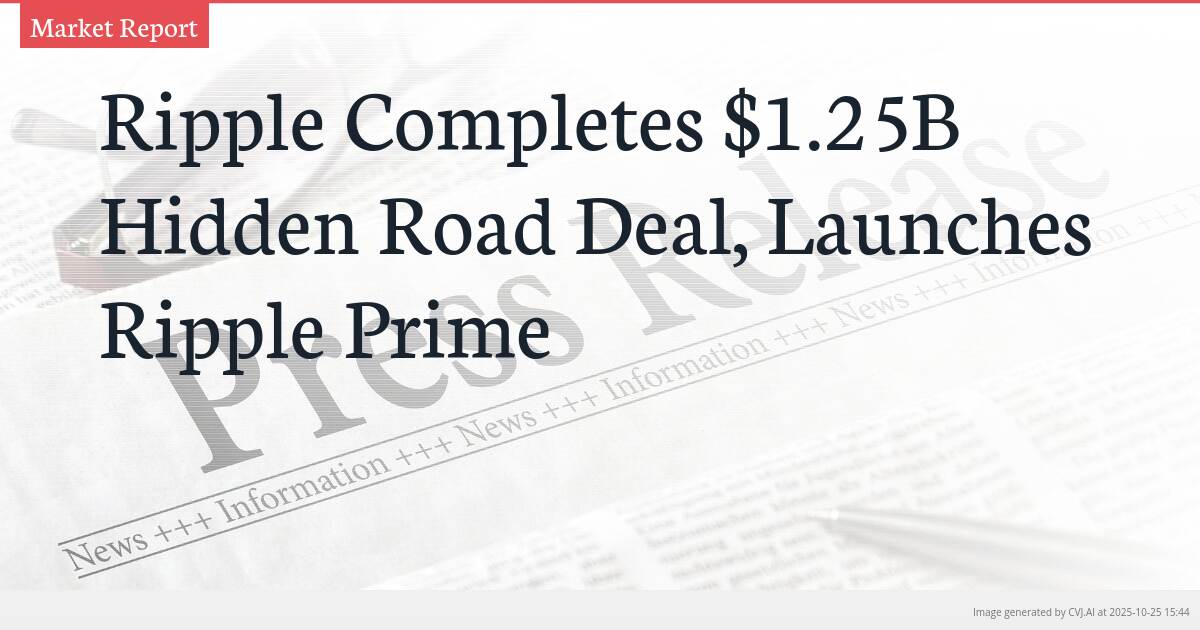This summary text is fully AI-generated and may therefore contain errors or be incomplete.
Introduction
Ripple has finalized its $1.25 billion acquisition of Hidden Road, rebranding the firm as Ripple Prime in a landmark move that positions the company as the first crypto-native firm to own and operate a global, multi-asset prime broker. This strategic acquisition significantly expands Ripple’s institutional offerings and integrates XRP directly into prime brokerage services, marking a pivotal moment in the convergence of traditional finance and digital assets. The deal represents Ripple’s fifth major acquisition in approximately two years, underscoring the company’s aggressive expansion into comprehensive financial services for institutional clients.
Key Points
- Ripple becomes first crypto company to own and operate a global multi-asset prime brokerage through the Hidden Road acquisition
- RLUSD stablecoin gains institutional traction with A rating from Bluechip and use as collateral across prime brokerage products
- Ripple has completed five major acquisitions in two years to build comprehensive institutional services spanning custody, payments, and treasury
Building the First Crypto-Owned Prime Brokerage
The completion of Ripple’s $1.25 billion purchase of Hidden Road represents a watershed moment for the cryptocurrency industry’s integration with traditional finance. Ripple President Monica Long confirmed the deal’s closure, emphasizing that the “future ahead is mighty bright” in her public statements. The acquisition transforms Ripple into the first cryptocurrency company to own and operate a global, multi-asset prime brokerage, a significant milestone that bridges the gap between digital assets and conventional financial markets.
Ripple Prime will operate on Hidden Road’s established backbone, a platform known for its rapid growth among non-bank prime brokers. Since Ripple announced the acquisition in April, business at the unit has tripled in size, indicating strong market reception to the integration. The newly formed entity will offer comprehensive services including clearing, financing, and prime brokerage across multiple asset classes—foreign exchange, derivatives, swaps, and digital assets. Hidden Road founder Marc Asch will remain involved in the business, working alongside Ripple CEO Brad Garlinghouse and other leadership during the integration phase.
RLUSD Gains Institutional Traction and High Ratings
Ripple’s institutional stablecoin, RLUSD, is already demonstrating significant institutional adoption within the prime brokerage ecosystem. According to company statements, RLUSD is being used as collateral across several prime brokerage products, with some derivatives clients choosing to hold balances in RLUSD rather than other currencies. This early adoption signals growing confidence in Ripple’s stablecoin among professional market participants.
The stablecoin’s institutional credibility received a significant boost from blockchain analytics firm Bluechip, which awarded RLUSD an A rating for stability, governance, and asset backing. Ripple cites this ranking as evidence of institutional trust in their stablecoin product. Furthermore, BNY Mellon’s role as the primary reserve custodian for RLUSD adds another layer of institutional validation, connecting Ripple’s digital asset offerings with established traditional finance infrastructure.
Strategic Acquisition Spree Strengthens Ripple's Infrastructure
The Hidden Road acquisition represents the latest move in Ripple’s aggressive expansion strategy, marking the company’s fifth major acquisition in approximately two years. This acquisition spree includes purchases of Metaco, Standard Custody, Rail, and GTreasury, all working under Ripple’s growing corporate umbrella. According to company comments, these strategic buys represent deliberate steps toward offering institutions a comprehensive suite of services that bridge digital assets and traditional markets.
CEO Brad Garlinghouse emphasized the strategic nature of these acquisitions in his public statements, noting that they support Ripple’s broader vision of “enabling an Internet of Value.” The company’s acquisition strategy appears focused on building capabilities across custody, payments, liquidity, and treasury services—creating an integrated ecosystem that can serve institutional clients’ diverse needs across both digital and traditional asset classes.
XRP Integration and Market Implications
Ripple’s latest strategic moves have significant implications for XRP’s utility and market position. Company executives have confirmed that Ripple Prime is exploring multiple ways to utilize XRP within the prime brokerage business, potentially creating new demand drivers for the digital asset. Monica Long’s optimistic statements about the future were accompanied by concrete actions rather than mere rhetoric, with reports indicating that Ripple Prime’s expansion and RLUSD’s institutional traction could make XRP more useful to banks and asset managers.
Brad Garlinghouse has repeatedly emphasized Ripple’s commitment to XRP, and the company’s latest steps position the token within a wider set of services aimed at professional users. Market analysts are closely watching how quickly institutions adopt these new tools and whether XRP establishes a steady, functional role within this expanding ecosystem. Currently, XRP has been trading quietly within a tight range between $2.30 and $2.50, showing resilience above $2.20 despite muted market activity. Some crypto analysts suggest this quiet phase might precede a significant rally, with long-term projections pointing to potential prices far beyond current levels.
The integration of blockchain tools to streamline Ripple Prime’s operations and reduce costs represents another key aspect of Ripple’s strategy. Executive remarks indicate plans to mesh payments, custody solutions, and stablecoin utility with prime brokerage functions to increase adoption among institutional clients. This approach could create new use cases for XRP while demonstrating the efficiency benefits of blockchain technology in traditional financial operations.
📎 Read the original article on newsbtc.com

